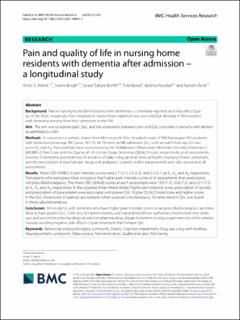| dc.description.abstract | Background: Pain in nursing home (NH) residents with dementia is commonly reported and may affect Quality of Life (QoL) negatively. Few longitudinal studies have explored how pain and QoL develop in NH residents with dementia starting from their admission to the NH.
Aim: The aim was to explore pain, QoL, and the association between pain and QoL over time in persons with dementia admitted to a NH.
Methods: A convenience sample, drawn from 68 non-profit NHs, included a total of 996 Norwegian NH residents with dementia (mean age 84.5 years, SD 7.6, 36.1% men) at NH admission (A1), with annual follow-ups for two years (A2 and A3). Pain and QoL were assessed using the Mobilization-Observation-Behavior-Intensity-Dementia-2 (MOBID-2) Pain Scale and the Quality of Life in Late-Stage Dementia (QUALID) scale, respectively, at all assessments. Severity of dementia, personal level of activities of daily living, general medical health, neuropsychiatric symptoms, and the prescription of psychotropic drugs and analgesics (opioids and/or paracetamol) were also assessed at all assessments.
Results: Mean (SD) MOBID-2 pain intensity scores were 2.1 (2.1), 2.2 (2.2), and 2.4 (2.1) at A1, A2, and A3, respectively. Participants who were prescribed analgesics had higher pain intensity scores at all assessments than participants not prescribed analgesics. The mean (SD) QUALID scores at each assessment were 19.8 (7.1), 20.8 (7.2), and 22.1 (7.5) at A1, A2, and A3, respectively. In the adjusted linear mixed model, higher pain intensity score, prescription of opioids, and prescription of paracetamol were associated with poorer QoL (higher QUALID total score and higher scores in the QoL dimensions of sadness and tension) when assessed simultaneously. No time trend in QoL was found in these adjusted analyses.
Conclusion: NH residents with dementia who have higher pain intensity scores or are prescribed analgesics are more likely to have poorer QoL. Clinicians, NH administrators, and national healthcare authorities need to look into strategies and actions for pharmacological and non-pharmacological pain treatment to reduce pain intensity while simultaneously avoiding negative side effects of pain treatment that hamper QoL. | en_US |

